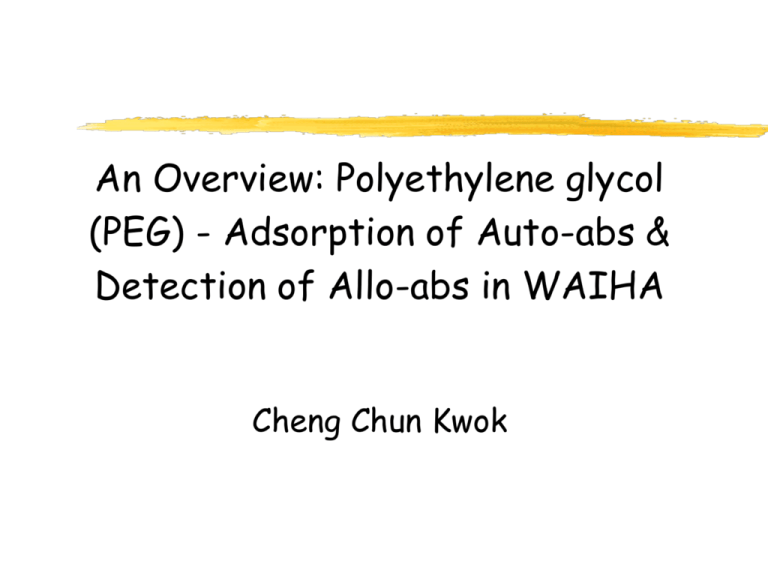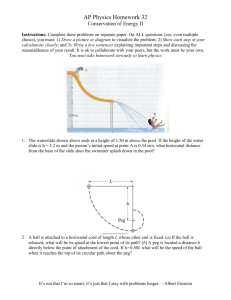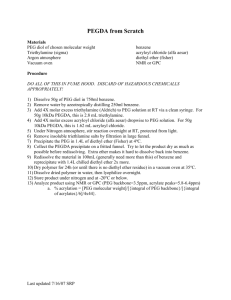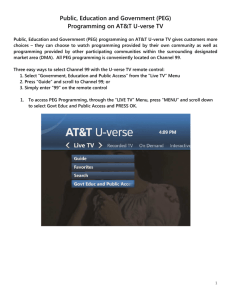PEG - Auto-abs Adsorption & Allo
advertisement

An Overview: Polyethylene glycol (PEG) - Adsorption of Auto-abs & Detection of Allo-abs in WAIHA Cheng Chun Kwok What is Polyethylene glycol (PEG)? Linear, neutral, water-soluble, non-toxic, ethylene glycol polymer. Consistency (liquid to solid) depends on Mol. Wt. Surfactant in industry (food, cosmetics, pharmaceutics) Biomedicine (dispersing agents, solvents, ointment, suppository bases, vehicles, tablet excipients). How Does PEG Work? Macro-molecules remove water concentrate abs abs uptake. Test mixture cannot be centrifuged. Ab detection depends on IAT phase. Anti-IgG AHG is recommended. PEG in Blood Banking First described by Nance & Garratty in 1987. Mol. Wt. around 3,500 - 4,000. Two types of PEG solutions. 20% PEG (20 g PEG / 100 mL NISS) (4 drops 20% PEG + 2 drops serum) PEG in LISS - commercial available (2 drops PEG + 2 drops serum) Liew & Duncan proposed to use in auto-abs adsorption & allo-abs detection in 1995. Auto-immune Hemolytic Anemia (1) 3 broad categories IHA: alloimmune, autoimmune, & drug-induced. AI: auto-abs on patient rbc in patient’s serum. Patient anemia ( Hb / Hct) / compensated? Anemia not present: DAT+ with free auto-abs. Anemia compensated: compensated WAIHA. Hemolytic anemia present: WAIHA. Difficult to distinguish bet them in BB. Auto-immune Hemolytic Anemia (2) Blood smear: spherocytes, reticulocytosis. Biochem: unconjugated bilirubin , LDH , Hp. Hemoglobinemia & hemoglobinuria. Serological tests: DAT, AS / abs id on serum &/or eluate. HA may due to structural membrane defect, erythrocytic enzyme deficient, abn Hb molecules. All Positive DAT Free Auto-abs present HA? No, affected not clearly understood. Positive DAT + free auto-abs - HA (not WAIHA). Positive DAT + free auto-abs + HA (WAIHA). Complicated. Lots of factors may involved. Possible Factors Influence an Antibody to cause Hemolytic Anemia (1) Thermal amplitude of abs reactivity. Titer in serum. Avidity for red cells antigen. amount of abs bound to red cells. Ability of abs to fix complement in vivo. Activity of individual’s macrophages. Possible Factors Influence an Antibody to cause Hemolytic Anemia (2) IgG subclass (IgG3 > IgG1 > IgG2 > IgG4) Rh abs mostly IgG1 & IgG3. Anti-K & anti-Fy usually IgG1. Anti-Jk mainly IgG3. Severe HDN mostly often associated with IgG1. Why Interested in WAIHA? Create problems in BB mask concomitant presence of clinically significant allo-abs. Identify clinically significant allo-abs to avoid HTR. Warm auto-abs adsorption procedures are tedious & time-consuming. Auto-abs react with all donor red cells compatible blood almost always impossible. Question: If we give phenotype matched blood, should we border the tedious auto-abs adsorption & allo-abs detection? What is Clinically Significant Ab? Known to cause HDN. Known to cause HTR. Unacceptably shorten survival of transfused red cells. Examples: ABO, Rh, Duffy, Kidd, Kell, SsU, & MUR. All of them are reactive at 37oC &/or IAT. All abs Reactive at 37oC &/or IAT are Clinically Significant? No. All clinically significant abs are reactive at 37oC &/or IAT. Abs reactive at 37oC &/or IAT may not be clinically significant. Can be distinguished in Blood Bank? not easy. When an allo-ab reactive at 37oC &/or IAT is identified antigen negative cells are selected for transfusion. Detection of allo-abs in patients with auto-abs (1) 1-in-5 dilute auto-abs to detect allo-abs is unreliable & should be strongly discouraged. “least incompatible” blood without allo-abs detection in urgent transfusion is unacceptable. Auto-adsorption is ideal but procedures are tedious, labor intensive & time-consuming. Urgent transfusion may be delay. Limitation: patient severely anemia or recently transfused. Detection of allo-abs in patients with auto-abs (2) Allogeneic adsorption is an alternative. Differential warm allogeneic adsorption. One-cell sample allogeneic adsorption. Differential warm allogeneic adsorption. Patient phenotypes not known / uncertain. Patient recently transfused. Tedious, time-consuming & labor intensive. Abs to high-incidence antigen may be removed. Repeat the procedures in transfused patients. Detection of allo-abs in patients with auto-abs (3) One-cell sample allogeneic adsorption. Patient not recently transfused. Patient phenotypes known. Abs adsorption with phenotype-matched red cells. Serum insufficient. Recently transfused patient: phenotype with reticulocyte-riched region red cells gel(LISS-IAT). Young red cells: MCHC ; acetylcholinesterase activity . Evaluations of PEG in WAIHA Abs Adsorption & Detection Barron & Brown Immunohematoloty 1997;13:119-22. Cheng et al Transfusion 2001;41:13-7. Judd & Dake Immunohematology 2001;17:82-5. Barron & Brown Immunohematoloty 1997;13:119-22. 19 patients with warm auto-abs were tested. 14/19 contained allo-abs / + auto-abs specificities. Adsorption: equal part papain-treated rbc & serum Vs equal part untreated rbc, serum, & 20% PEG in PBS. Detection: LISS (2 drops serum + 2 drops LISS + 1 drop 5% reagent cells). Vs PEG-IAT (6 drops serum/PEG mixture + 1 drop 5% reagent cells). ?? Optimal reactivity of 20% PEG; serum:PEG:rbc = 2:4:1 (Nance & Garratty, Am J Clin Pathol 1987). Barron & Brown Immunohematoloty 1997;13:119-22. Ref PEG serum serum 20% PEG papain-treated red cells red cells ?? Optimal reactivity of 20% PEG; serum:PEG:rbc = 2:4:1 (Nance & Garratty, Am J Clin Pathol 1987). Barron & Brown (Result 1) Immunohematoloty 1997;13:119-22. Total adsorption time Total number of adsorption Ref PEG 59.5 hrs 10 hrs 42x 30x Average time 161.5 mins 30 mins Abs reactivity 4 stronger 5 stronger Remarks ND - Not Detected. anti-K, -Fya, 2 -E 1 auto- ND anti-E, -Jkb, 3 -C 1 auto- & 2 allo- ND Ref: 10 mins enzyme + 10 mins wash + 60 mins incubation + 5 mins harvest. PEG: 15 mins inucbation + 5 mins harvest. Barron & Brown (Result 2) Immunohematoloty 1997;13:119-22. 2 allo-abs not detected with PEG. Anti-K weak reactive with ref but non-reactive with PEG. Anti-Jkb microscopic positive but non-reactive with PEG. ?? Optimal reactivity of 20% PEG; serum:PEG:rbc = 2:4:1 (Nance & Garratty, Am J Clin Pathol 1987). ?? Macroscopic but not microscopic reading at all stages of LISS, + IAT reading, is recommended (Issit & Anstee, Applied blood group Serology). Barron & Brown (Result 3) Immunohematoloty 1997;13:119-22. Decreases in adsorption time. Efficient & cost-effective. Very weak allo-abs may not be detected. Option to reduce time & cost in adsorptions. When non-detection is suspected, use standard procedures. Cheng et al Transfusion 2001;41:13-7. 16 patients with warm auto-abs were tested. 8/16 contained allo-abs / + auto-abs specificities. Adsorption: equal part untreated rbc & serum Vs equal part untreated rbc, serum, & PEG (PeG). Detection: gel (LISS-IAT) Vs PEG-IAT (4 drops serum/PEG mixture + 1 drop 5% reagent cells). Cheng et al Transfusion 2001;41:13-7. Conventional PEG serum serum PeG untreated red cells red cells Cheng et al (Result 1) Transfusion 2001;41:13-7. Conventional PEG Total adsorption time 2,400 hrs 360 hrs Mean time 150 mins 22.5 mins Mean fold 2.5x 1.5x 2 Not adsorbed All adsorbed Auto-abs adsorption (3x) Allo-abs detection Con: 60 mins incubation. PEG: 15 mins incubation. All are demonstrated Cheng et al (Result 2) Transfusion 2001;41:13-7. 3 allo-anti-E, 1 allo-anti-e, & 3 allo-anti-Mur were able to be demonstrated by both methods. Reactivity strength not mentioned & compared between the two methods. 40% efficiency in number of adsorptions. 85% decreases in adsorption time. Effective in allogeneic adsorption. Cheng et al (Result 3) Transfusion 2001;41:13-7. Method awaits standardization. Fully replace conventional method not recommended. Further studies on weak allo-abs loss during adsorption or IAT. Other techniques incorporated to enhance abs detection - gel (LISS-IAT). Safe to male has no recent transfusion history / female has not been pregnant or no recent transfusion history. Judd & Dake Immunohematology 2001;17:82-5. 11 warm reactive auto-abs selected to compare ZZAP & PEG adsorption. 12 allo-abs were selected to compare abs detection after ZZAP- & PEG-adsorption. Adsorption: ZZAP adsorption (ficin) Vs equal part untreated rbc, serum, & PEG (PeG). Detection: NISS-IAT (3 drops serum + 1 drop 3-4 % reagent cells, 60 mins 37oC, PS-AHG) Vs PEG-IAT (4 drops serum/PEG mixture + 1 drop 5% reagent cells). ?? NISS-IAT: serum to cell = 2 to 1 (Technical Manual). Judd & Dake Immunohematology 2001;17:82-5. ZZAP PEG serum serum PeG ZZAP (ficin)treated red cells red cells Judd & Dake (Result 1) Immunohematology 2001;17:82-5. ZZAP Auto-abs removal power Comparable Allo-abs studies anti-Fya anti-c anti-Jka ND - Not Detected. PEG 1 rxn grade or more weaker 1+S 1+S 1+ - 2+S ND weak w - 1+w Judd & Dake (Test & Result 1) Immunohematology 2001;17:82-5. Two fold adsorption of 7 allo-abs (2 anti-D, 1 anti-E, 1 anti-K, 1 anti-Jka, & 1 anti-Jkb) with antigen negative red cells. PEG-serum parallel run with saline-serum. Titration studies on adsorbed sera with saline: 60 mins at 37oC with anti-IgG. 5/7 were 2 folds lower with PEG. 2/7 were 1 fold lower with PEG. Titers of PEG-serum Vs saline-serum : 2-8 Vs 4-32. ?? Serially dilute PEG-serum mixture with saline. Judd & Dake (Test & Result 2) Immunohematology 2001;17:82-5. To demonstrate abs activity loss in PEG-adsorption procedure but not on post-adsorption storage. Incubate PEG-serum & saline-serum at 37oC, 15 mins, centrifuge & harvest the supernatants. Measure the IgG levels with nephelometer. PEG-serum mixture: 128-243 mg/dL. Saline-serum mixture: 265-505 mg/dL. IgG level of PEG-serum mixture was 50% lower. ?? Compare IgG levels of ZZAP & PEG adsorbed serum. Judd & Dake (Result 2) Immunohematology 2001;17:82-5. PEG adsorption effective in removing auto-abs. Fail to detect allo-abs due to Ig precipitation. PEG Does precipitate Immunoglobulin ?? Leger RM, Ciesielski DC, & Garratty G (1) Transfusion 1999;39:1272-3. Investigate possible loss of ab reactivity of PEG-adsorbed sera upon storage. 7 sera contain single ab specificities Anti-E, -K, -Fya, & -Jka. 2 sham PEG-adsorptions with ag neg red cells. Fresh PEG-adsorbed serum reactivity: 1+ - 3+. PEG-sera mixture left at 4oC for 1 - 4 days. Leger RM, Ciesielski DC, & Garratty G (2) Transfusion 1999;39:1272-3. Stored sera mixture divided into 2 aliquots. ‘Mixed’ & ‘Settled’ ‘Mixed’ was mixed before sampling. ‘Settled’ was allowed ppt to form, settle, & sample the clear supernatant. PEG-adsorbed sera mixture were tested and compared to the adsorbed sera at the time of adsorption. Leger RM, Ciesielski DC, & Garratty G (2) Transfusion 1999;39:1272-3. PEG-adsorbed Sera 4oC Storage PEG-unadsorbed Sera 1 x anti-E Mix Before Sampling Centrifuge & Sample Supernatant 1+S 1+ 1/2 + 1 x anti-Fya 2+ 2+ 1+ 5 x abs (day 0) - 5 x abs (day 4 ) - Same Degree Same Degree 4 abs Same degree 1 anti-Fya weaken Leger RM, Ciesielski DC, & Garratty G (3) Transfusion 1999;39:1272-3. Precipitate formed in stored PEG-serum mixture. Once precipitate formed, DO NOT centrifuge. Remix the mixture before sampling. Test PEG-adsorbed serum on the day of preparation. What Make the Differences? Method to separate serum-PEG mixture after adsorption. ?? Centrifugation force ?? ?? Duration ?? ?? Temperature ?? How to Perform PEG-incorporated One-cell Sample Allogeneic Adsorption Mix equal parts of patient serum + PEG + phenotyped packed red cells incubate at 37oC, 15-30 minutes centrifuge & harvest adsorbed serum/PEG mixture perform PEG-IAT with SC / PC 4 drops serum/PEG mixture to 1 drop 5% red cells 37oC, 15-30 minutes, IAT(anti-IgG) Advantages of PEG Enhance auto-abs adsorption. Prior red cells treatment not necessary. Direct benefit: time saving, & minimize the delay of urgent transfusion in WAIHA patients. Indirect benefit: labor & cost effectiveness. Disadvantages of PEG Precipitates Ig. Weak allo-abs may not be detected after PEG adsorption. Remedy?? Avoid overnight storage PEG-serum mixture at 4oC - precipitate formed. Adsorbed PEG-serum mixture should be tested as soon as possible. precipitate formed, mix thoroughly before sampling & DO NOT centrifuge. Other techniques may be incorporated to enhance abs detection after PEG adsorption gel (LISS-IAT)?? Cells to PEG/serum mixture ratio. AHG in gel: MS/PS. Conclusion Potential technique in WAIHA auto-abs adsorption & allo-abs detection. Safe to male has no recent transfusion history / female has not been pregnant or no recent transfusion history. ?Method to separate serum-PEG mixture after adsorption. End Questions & Comments are welcome







